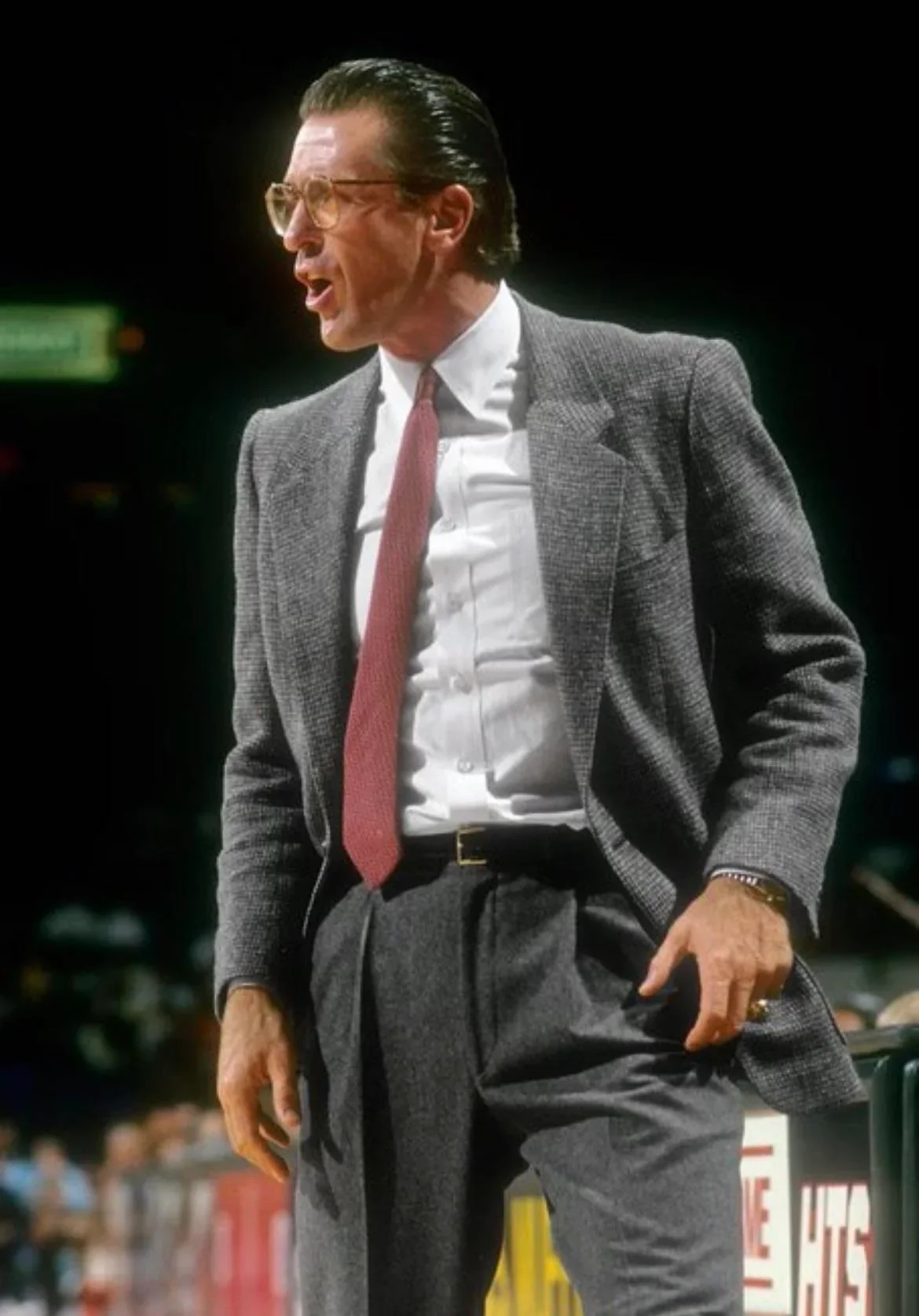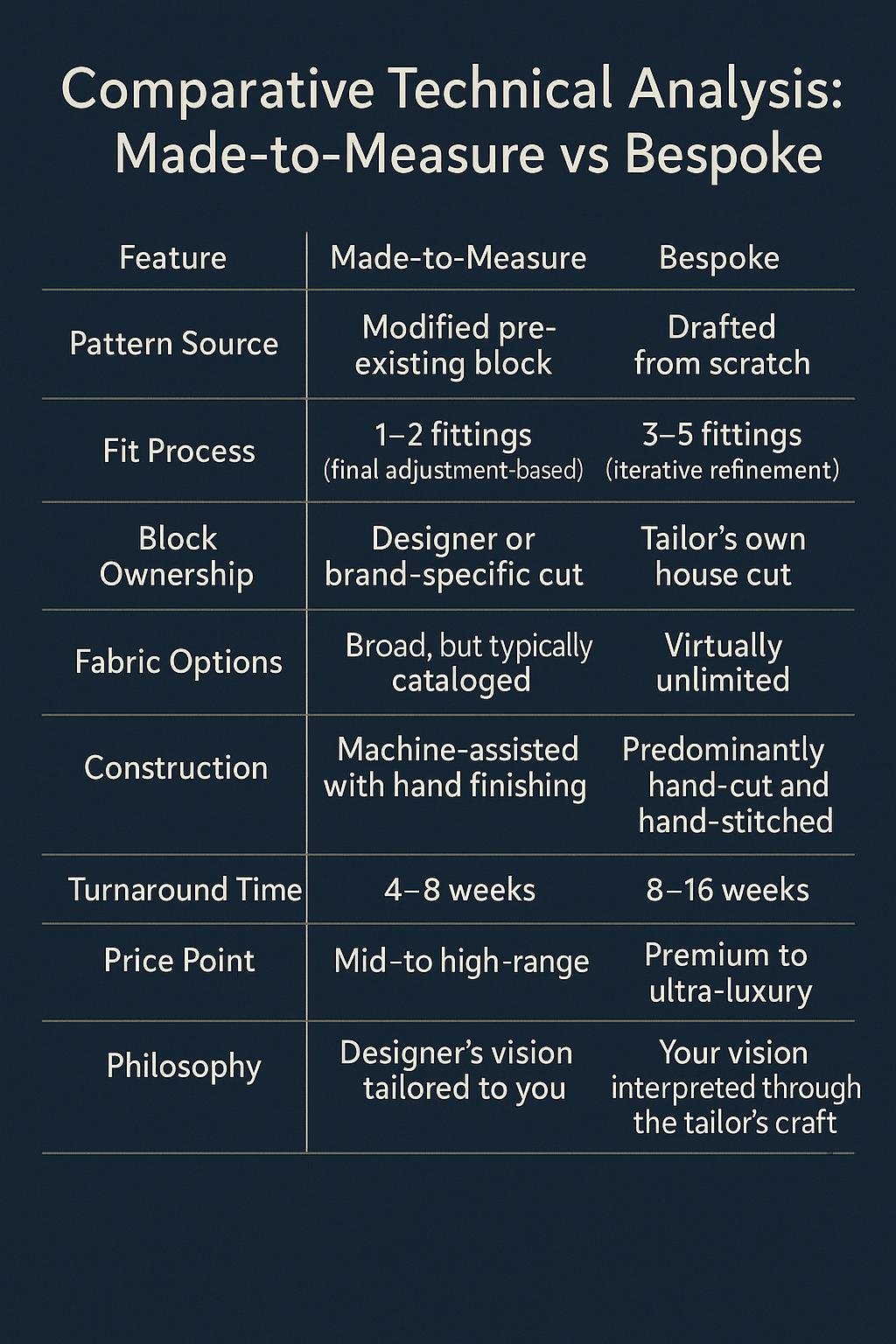Made-to-Measure vs Bespoke: The Technical Truth Behind the Tailoring Terms
Made-to-Measure vs Bespoke: The Technical Truth Behind the Tailoring Terms
The debate between made-to-measure and bespoke tailoring is one of the most misunderstood topics in menswear. Both are forms of custom tailoring, both produce exceptional garments, and both rely on craftsmanship and pattern engineering. Yet they differ fundamentally in methodology, pattern origin, and philosophical intent.
At Cutting Room Bespoke, we approach this discussion not from hierarchy, but from clarity — because made-to-measure isn’t “less than” bespoke; it’s simply different in process and scope.
Understanding the Foundations: Pattern-Making and the Block System
Before diving into the differences, let’s start with the foundation of any tailored garment: the pattern.
A pattern is the two-dimensional blueprint that dictates how fabric will be cut and shaped around the body. All tailoring — from ready-to-wear to fully bespoke — begins with one. The difference lies in how that pattern is generated and manipulated.
In ready-to-wear, patterns are standardized: one pattern per size.
In made-to-measure, the tailor starts with an existing base block — a master pattern that defines a designer’s proportions and house aesthetic — and modifies it to fit the client’s unique measurements.
In bespoke, a completely new pattern is drafted from scratch, designed exclusively for the client’s body and posture.
This distinction is crucial. It defines how flexible the tailoring process can be, what aesthetic language the garment expresses, and how deeply personal the result becomes.
Made-to-Measure: Precision Within a Defined Aesthetic
Pat Riley helped make the iconic Armani cut famous — seen here in a classic gray Armani sport coat. And that’s the essence of made-to-measure: if you love a designer’s vision, have it tailored precisely for you.
Made-to-measure (MTM) tailoring is a highly engineered process that blends the designer’s artistic vision with the client’s anatomical data. The key lies in the block, or base cut, used as the starting point.
Let’s take a made-to-measure Armani suit as an example. Armani’s tailoring block is characterized by:
A soft, lightly padded shoulder,
A clean chest with minimal suppression,
A long, fluid line through the body,
A natural drape with restrained waist shaping.
When you order an Armani made-to-measure suit, the tailor doesn’t reinvent the cut. Instead, they adjust the existing Armani block — altering key dimensions such as chest width, waist suppression, sleeve pitch, shoulder slope, and trouser rise — to achieve a fit that mirrors your body while maintaining Armani’s aesthetic integrity.
In this way, made-to-measure is not “semi-custom.” It’s customized within a framework — a technical process of grading and proportion adjustment that honors the designer’s house silhouette.
Technical Advantages of Made-to-Measure
Consistency: The garment retains the designer’s proportions, ensuring that it reflects a recognizable and coherent aesthetic.
Efficiency: The use of a pre-existing pattern allows for faster production with high precision.
Accessibility: Made-to-measure suits are typically more affordable than bespoke due to reduced labor in pattern drafting and fittings.
Perceived Limitations — and the Truth
Many claim that made-to-measure is “limited.” Technically, it is — but only in that the garment must preserve the structural logic and aesthetic DNA of the original block.
That isn’t a flaw; it’s a design discipline.
A made-to-measure Armani will never be mistaken for a Zegna — and that’s precisely the point.
Bespoke Tailoring: Engineering a Pattern From the Ground Up
Bespoke tailoring represents the highest form of pattern creation and garment construction. The process begins not with a block, but with a blank sheet — and a cutter’s eye for proportion.
A bespoke tailor drafts a new pattern by hand, mapping dozens of measurements and posture assessments:
Neck circumference and shoulder angle,
Chest balance (left vs. right),
Arm rotation and sleeve pitch,
Stance, posture, and body asymmetry.
These measurements are plotted and connected using centuries-old pattern-drafting techniques to create a one-of-one blueprint. This pattern is unique — it will never be reused, as it reflects the client’s anatomy and natural bearing.
Once drafted, the cloth is cut and basted together into a preliminary form. This is the baste fitting stage, where the client tries on the suit while the structure is still rough. Adjustments are made iteratively through multiple fittings (forward and final), refining the shape and balance of the garment in three dimensions.
The Technical Edge of Bespoke
Pattern Creation: Each garment starts with a fresh pattern. No pre-existing block is used.
Manual Adjustments: Every curve, dart, and seam is manipulated by the cutter’s hand to control drape, tension, and silhouette.
Fit Evolution: The garment evolves through multiple fittings — each refining the spatial relationship between fabric and body.
The Myth of “Unlimited Freedom” in Bespoke
A common misconception is that bespoke tailoring is a free-form artistic blank canvas. While technically you can request anything, the reality is that every tailoring house has a signature cut — a “house style” that defines its aesthetic lineage.
For example:
Savile Row houses often favor structured shoulders, suppressed waists, and roped sleeveheads.
Neapolitan tailors prefer soft constructions, light canvassing, and natural shoulders.
Parisian ateliers emphasize sleek, architectural balance with subtle waist shaping.
Even in bespoke, most cutters work within their house block, a conceptual framework that reflects decades of refinement. The difference is that they draft a fresh pattern each time rather than modifying an existing one.
So, bespoke is not the absence of boundaries — it’s the mastery of them.
Made to Measure vs Bespoke cheat sheet
Choosing Between the Two: Fit vs Philosophy
Choosing between made-to-measure and bespoke isn’t about superiority — it’s about what kind of relationship you want with your clothes.
Made-to-measure is perfect for the client who values design fidelity. You’re wearing a designer’s architecture — cut precisely for your proportions.
Bespoke is for the client who seeks creative partnership — working with the cutter to express individuality through proportion, detail, and silhouette.
Both represent craftsmanship. Both require skill, pattern knowledge, and fit expertise. And both, when done properly, result in a garment that enhances posture, confidence, and movement.
At Cutting Room Bespoke: Tailoring Without Hierarchy
At Cutting Room Bespoke, we reject the notion that bespoke is “better” than made-to-measure. The two are different tools for different intentions.
Our philosophy is rooted in pattern integrity and anatomical truth — while we always draft a fresh pattern for each suit, what matters most is that each garment embodies a synthesis of fit, balance, and design coherence.
In the end, tailoring isn’t about status — it’s about precision, proportion, and presence.


